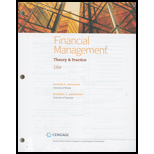
Concept explainers
Integrated Waveguide Technologies (IWT) is a 6-year-old company founded by Hunt Jackson and David Smithfield to exploit metamaterial plasmonic technology to develop and manufacture miniature microwave frequency directional transmitters and receivers for use in mobile Internet and communications applications. IWT’s technology, although highly advanced, is relatively inexpensive to implement, and its patented manufacturing techniques require little capital as compared to many electronics fabrication ventures. Because of the low capital requirement, Jackson and Smithfield have been able to avoid issuing new stock and thus own all of the shares. Because of the explosion in demand for its mobile Internet applications, IWT must now access outside equity capital to fund its growth, and Jackson and Smithfield have decided to take the company public. Until now, Jackson and Smithfield have paid themselves reasonable salaries but routinely reinvested all after-tax earnings in the firm, so dividend policy has not been an issue. However, before talking with potential outside investors, they must decide on a dividend policy.
Your new boss at the consulting firm Flick and Associates, which has been retained to help IWT prepare for its public offering, has asked you to make a presentation to Jackson and Smithfield in which you review the theory of dividend policy and discuss the following issues.
- (1) What is meant by the term “distribution policy”? How has the mix of dividend payouts and stock repurchases changed over time?
- (2) The terms “irrelevance,” “dividend preference” (or “bird-in-the-hand”), and “tax effect” have been used to describe three major theories regarding the way dividend payouts affect a firm’s value. Explain these terms, and briefly describe each theory.
- (3) What do the three theories indicate regarding the actions management should take with respect to dividend payouts?
- (4) What results have empirical studies of the dividend theories produced? How does all this affect what we can tell managers about dividend payouts?
Trending nowThis is a popular solution!

Chapter 14 Solutions
FINANCIAL MANAGEMENT(LL)-TEXT
- An investment that is worth $27,200 is expected to pay you $62,280 in 5 years and has an expected return of X percent per year. What is X?arrow_forwardDon't used Ai solution and don't used hand raitingarrow_forward3-7. (Working with an income statement and balance sheet) Prepare a balance sheet and income statement for Kronlokken Company from the following scrambled list of items. a. Prepare a common-sized income statement and a common-sized balance sheet. Interpret your findings. Depreciation expense $66,000 Cash 225,000 Long-term debt 334,000 Sales 573,000 Accounts payable 102,000 General and administrative expense 79,000 Buildings and equipment 895,000 Notes payable 75,000 Accounts receivable 153,000 Interest expense 4,750 Accrued expenses 7,900 Common stock 289,000 Cost of goods sold 297,000 Inventory 99,300 Taxes 50,500 Accumulated depreciation 263,000 Prepaid expenses 14,500 Taxes payable 53,000 Retained earnings 262,900 ||arrow_forward
- x3-3. (Preparing an income statement) Prepare an income statement and a common- sized income statement from the following information. MyLab Sales Cost of goods sold General and administrative expenses Depreciation expenses Interest expense Income taxes $525,000 200,000 62,000 8,000 12,000 97,200arrow_forward3-9. (Working with a statement of cash flows) Given the following information, prepare LO3 a statement of cash flows. Increase in accounts receivable Increase in inventories Operating income Interest expense Increase in accounts payable Dividends $25 30 75 25 25 15 20 Increase in net fixed assets 23 Depreciation expense Income taxes 12 17 Beginning cash 20 Increase in common stockarrow_forward3-4. (Preparing a balance sheet) Prepare a balance sheet from the following informa- LO2 tion. What is the net working capital and debt ratio? Cash $50,000 Account receivables 42,700 Accounts payable 23,000 Short-term notes payable 10,500 Inventories 40,000 Gross fixed assets 1,280,000 Other current assets 5,000 Long-term debt 200,000 Common stock 490,000 Other assets 15,000 Accumulated depreciation 312,000 Retained earnings ? MyLabarrow_forward
- Consider a situation involving determining right and wrong. Do you believe utilitarianism provides a more objective viewpoint than moral rights in this context? Why or why not? How about when comparing utilitarianism to principles of justice? Share your thoughts. Reflect on this statement: "Every principle of distributive justice, whether that of the egalitarian, the capitalist, the socialist, the libertarian, or Rawls, in the end is illegitimately advocating some type of equality." Do you agree or disagree with this assertion? Why might someone claim this, and how would you respond?arrow_forwardI need help checking my spreadsheet. Q: Assume that Temp Force’s dividend is expected to experience supernormal growth of 73%from Year 0 to Year 1, 47% from Year 1 to Year 2, 32% from Year 2 to Year 3 and 21% from year3 to year 4. After Year 4, dividends will grow at a constant rate of 2.75%. What is the stock’sintrinsic value under these conditions? What are the expected dividend yield and capital gainsyield during the first year? What are the expected dividend yield and capital gains yield duringthe fifth year (from Year 4 to Year 5)?arrow_forwardwhat are the five components of case study design? Please help explain with examplesarrow_forward
 Intermediate Financial Management (MindTap Course...FinanceISBN:9781337395083Author:Eugene F. Brigham, Phillip R. DavesPublisher:Cengage Learning
Intermediate Financial Management (MindTap Course...FinanceISBN:9781337395083Author:Eugene F. Brigham, Phillip R. DavesPublisher:Cengage Learning
 Survey of Accounting (Accounting I)AccountingISBN:9781305961883Author:Carl WarrenPublisher:Cengage Learning
Survey of Accounting (Accounting I)AccountingISBN:9781305961883Author:Carl WarrenPublisher:Cengage Learning Financial Reporting, Financial Statement Analysis...FinanceISBN:9781285190907Author:James M. Wahlen, Stephen P. Baginski, Mark BradshawPublisher:Cengage Learning
Financial Reporting, Financial Statement Analysis...FinanceISBN:9781285190907Author:James M. Wahlen, Stephen P. Baginski, Mark BradshawPublisher:Cengage Learning




